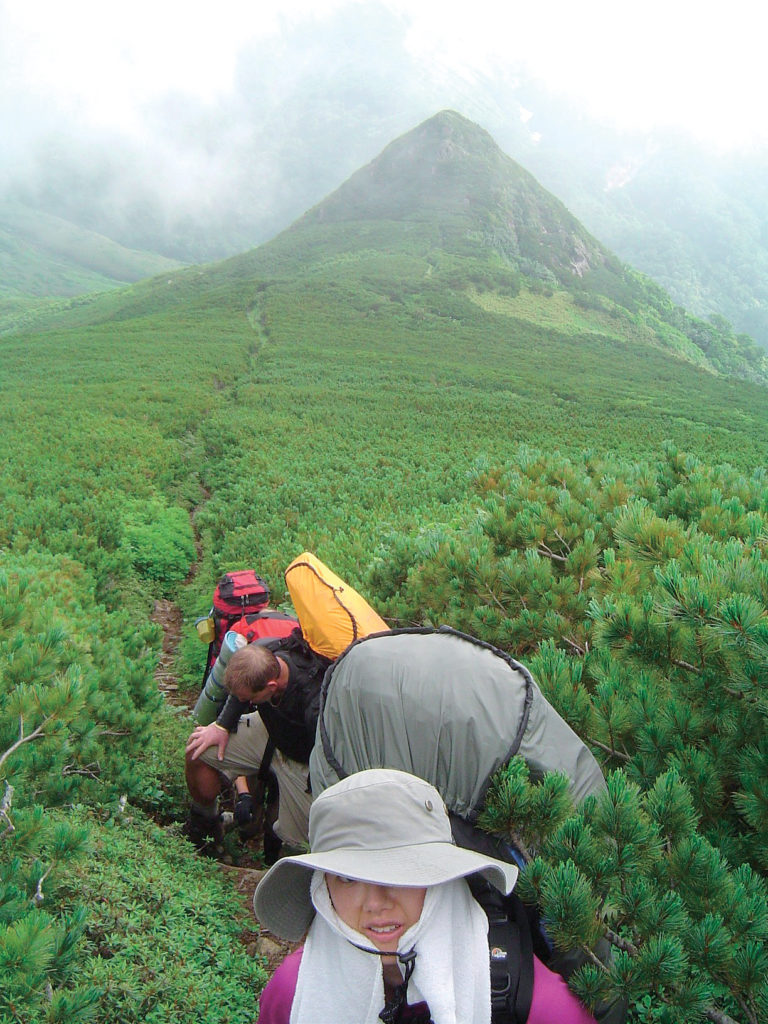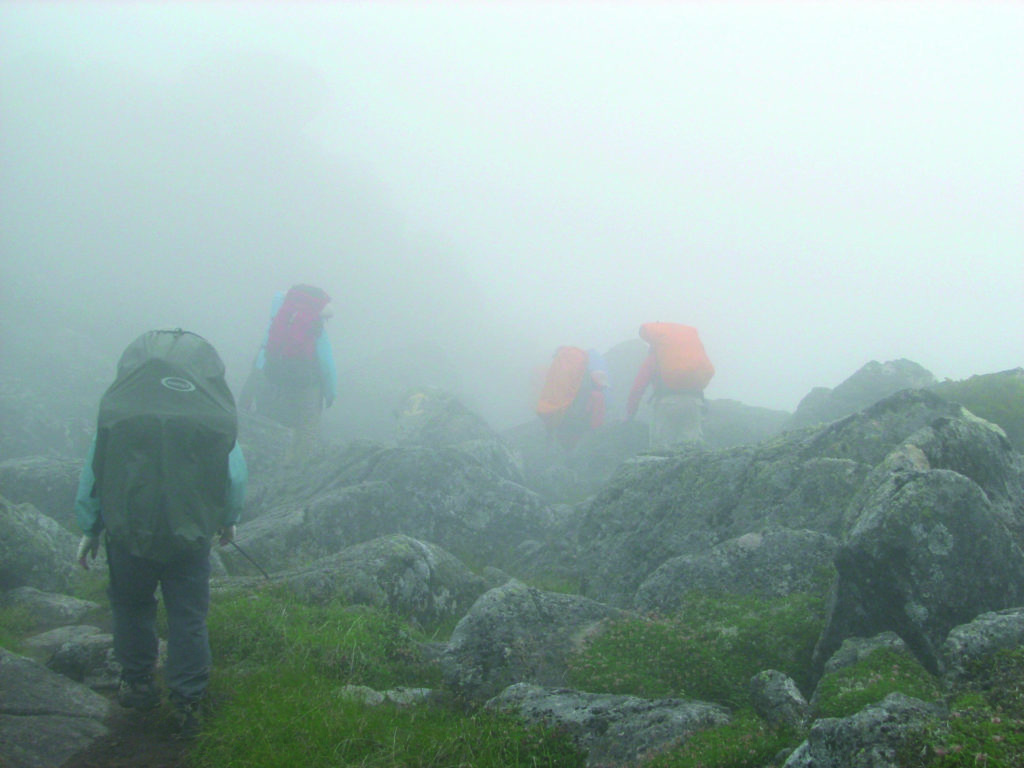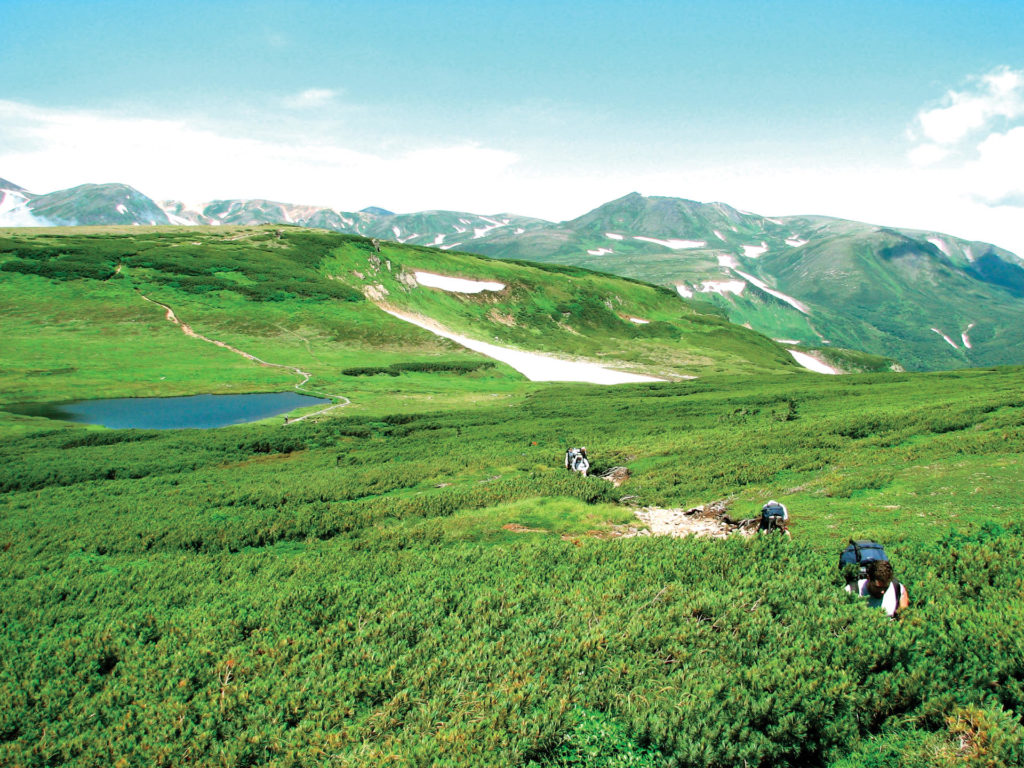There I was in furious winds, hard-driving horizontal rain, looking up at the next section of the hike and wondering what the hell I was doing there. I was exhausted, tired, my hands and face were cut, scratched to bits. My rain gear was torn from top to toe and, to put the icing on the cake, my backpack had a very large hole in it. To put it mildly, I wasn’t in a good mood. I had just finished six hours of hiking (or should I say ripping my way through low, uncut alpine shrub covering the trail) and had only gone a couple of kilometers, if that. I was about to take on what appeared to be a difficult, steep two-hour climb up and over a peak standing between me and the hut for which I was headed. Five hours later I arrived.

That was 10 years ago, but she has still managed to keep her magic and charm. Daisetsu-zan National Park is the biggest National Park in Japan, sitting in the center of the big island of Hokkaido and covering 230,000 hectares of alpine mountain peaks, rivers and forests, and teeming with wildlife such as brown bears, deer, foxes and birds.
The park also has two active volcanoes, lying at the northern (Asahi-dake) and southern (Tokachi-dake) ends of the park. There are a number of trails linking these two mountains—known has the “Grand Traverse.”
This majestic trek spans 55 kms. of linking trails taking you to the roof of the park and over some of Hokkaido’s famous peaks. It can take anywhere from five to seven days, depending on a number of factors.
Most people I’ve met try to do it in five days as suggested in Lonely Planet’s “Hiking in Japan” book. If you are a fit, serious hiker and don’t mind hiking in any weather—and are prepared to put in eight hours a day of full-on hiking— the five days won’t be a problem. Yet for most people I would suggest six to seven days. The park has a habit of turning weekend warriors into mice, and I think she loves it. But don’t be scared off, just give yourself plenty of time and do each day within your limits.
Pig Tip: I can’t tell you how many times I have run into people trying to do it in five days and, who, by the third or fourth day, are burned out and suffering from blisters. I’ve had to cut a couple of treks short once to help people off the mountain.
One of the most difficult parts of doing the Grand Traverse is the hike up on the first day. Most of the trek takes place at an altitude of 1,500 to 2,000 meters with ups and downs of 300 to 600 meters. Nearly the entire trek is above the tree line. To avoid a big part of the hike up, you can jump on the gondola at Asahi-dake Onsen Village, the most popular and convenient starting point.
There is a trail from the bottom of the gondola to the top, but with a heavy backpack (which usually is the case on the first day of any long trek), the gondola is tempting, as it will save you two to three hours of pain. From the top of the gondola you still have a tough climb up Asahi-dake before getting to the first campsite.
Pig Tip: If you are planning to hike all the way from the bottom of the gondola to the top of Asahi-dake and down to the first campsite, I suggest giving yourself plenty of time to do it; at least eight hours. The climb up is difficult and a real hump with a heavy pack.
If you have time, there are many other great hikes in the park. A lot of people have their sights on doing the Grand Traverse trek and forget about the rest of the park. A good thing to do if you have time is camp a couple of days at Uraasahi Campsite near Asahi-dake and spend a day doing the trail to Naka-dake Onsen. It is the only natural hot spring in Daisetsu-zan.
You can also do the trail over to Aibetsu-dake, one of the best peaks in the park. Last year I tried to take people to this towering peak four times and had to turn back every time. We would see Aibetsu-dake in the distance as we were making our way toward it and I would think “Yes” but, as soon as we started to climb, the clouds would settle in, and we couldn’t even see our hands, let alone our feet. If you do make it to the top, the spectacular views make the hard climb well worth it.
I for one love this park. Her magic has lured me back every year since I first ventured in more than 10 years ago. I have made more than 100 trips to date, from day hikes right up to two-week treks and everything in between.
Like any grand dame, she has her moods. When she’s in a good disposition, you can enjoy some of the best hiking anywhere with fantastic weather, fields of beautiful alpine flowers, amazing views and even the wildlife will come out and say hello. But when she is in a foul temperament, she can make your life a living hell, putting the best outdoor person to the test.

Pig Tip: A few years ago, I was in the park for a couple of weeks, and it rained nearly every day. The next year doing the same trek, I had beautiful sunny days the whole time except for the first day.
The park has changed a lot over the last decade. When I first began exploring her, most of the trails were overgrown with thick alpine bush and weren’t maintained very well. The going was tough, to say the least. Nowadays, with the park becoming more popular with local and overseas hikers, more time and money has been spent on maintenance. Most of the overgrowth has been cut back, and some problem points on the Grand Traverse trail have been fixed. The last of the most difficult sections was cut just last year.
As a result, in my opinion, the park lost a bit of her character. I feel they should have kept some of those difficult sections to preserve more of her personality. Not all, but some. Yet Daisetsu-zan still has plenty of magic and charm to spare. Whether it’s your first time or 21st, you’ll always discover something new within her and within yourself.
Getting There
You can either fly into Sapporo (New Chitose Airport) or directly into Asahikawa, the nearest big city to Daisetsu-zan. From Sapporo, catch the 6.50 a.m. train from JR Sapporo Station, arriving in Asahikawa at 8.15 a.m. From there, you can catch the 9.10 a.m. bus (#4) to Asahi-dake Onsen Village. The bus stop is in front of Asahikawa Station on the main street. The bus will get into Asahi-dake village about 11:15 a.m.
There are later buses, but you have to walk about an hour to another bus stop which is real hard to find. If you catch the 9.10 a.m. bus, you will be on the mountain in time to get to the first campsite. If you catch a later one, you will be pushing it unless you take the gondola or stay at night at the campground or one of the many accommodations in the village. If you fly directly to Asahikawa, you can catch one of the buses departing from in front of the airport each hour to JR Asahikawa Station.
Pig Tip: Lonely Planet’s “Hiking in Japan” says there are free buses from the train station to Asahi-dake Onsen Village, but the buses are no longer in service.
What to Bring?
Gas. If you are flying in, gas canisters will be a problem, since most airlines won’t let them on the plane. The Shirakaba YHA in Asahi-dake Village sells EPL gas and Primus, but they don’t sell white gas for MRS burners.
Full rain gear is always a good thing to have while doing the Grand Traverse. I was at one of the huts and ran into an American guy stuck there for three days because he didn’t have any rain gear and it hadn’t stopped pouring the whole time. He told me he had missed his flight back to Tokyo. When I asked why he hadn’t brought any, he said he didn’t think he would need it.
Water filter pump. You must purify the water in Daisetsu-zan, and the easiest way to do that is with a filter pump. One of the problems in Daisetsu-zan is finding good water, especially around late August and September. Most of the water at the campsites and huts comes from snowmelt and things can change a lot each year, depending on the winter snowfall and summer temperatures. Usually the north side (Asahi-dake side) of the park is OK, but as you move over to the south side (Tokachi-dake side) water can be hard to find.
The rule of thumb while doing the Grand Traverse is, if you see water, fill up. Having a pump makes that job a lot easier and saves time.
Pig Tip: Boiling water uses too much gas, which you have to carry, adds extra weight, plus you have to wait around for your water to cool down. Water tablets or drops take too long. A good pump is the only way to go. Extra plastic fold-up water bottles are not a bad idea either. Clothes pegs and a cord can come in handy when you are in a hut and want to hang up and dry your clothes.
Campsites & Huts
There are many huts along the Grand Traverse trail, and every hut has a campsite. It’s impossible to do the whole trek without camping, as there is one long section with no hut. All the huts are very basic, so you’ll have to bring everything you need. There are two huts on the Asahi-dake side of the park that charge a fee to stay: Kurodake-sanso (hut) and Hakuun-dake hut. Kurodake-sanso is very hiker-friendly, and you can rent sleeping bags and buy beer. All the other huts in the park are not staffed and free.
When to Go

The park is officially open from July until the end of September, but you can head in there any time if you choose. The best time to do the grand traverse is between July and August. Doing the trek in June, September or October depends on a few things. In June it is a matter of how much snow is still around and the weather. A lot of the trail can still be covered in snow which turns to ice if things chill down. The other thing to consider is visibility. If it is very low, it is easy to lose the trail on the ice fields. At least you will have no problems with finding water.
September and October is a different story. Water is your biggest problem. The first snows come in September, but it changes year to year, and the temperature can drop quickly. I usually don’t do the Grand Traverse trail after August, choosing to spend my time in other parts of the park.
Seasonal Highlights
June to July: In June and July, the park comes alive with sight of beautiful wild flowers. From Hakuun-dake hut, take a short walk up Midori-dake (takes less than an hour) and check out the flowers on all sides.
August: August usually has the warmest weather. A three-season sleeping bag or a good summer bag is all you need. Expect anything from heavy rain to bright sunny days.
September: Daisetsu-zan is one of the first places in Japan to don her spectacular autumn coat. It changes year to year but usually is best mid-September. Make sure to have a very good three- or four-season sleeping bag, as the nights can drop to -1C to –5C and colder.
October: I love this time of year in the park. The park has officially closed and you can have the place to yourself but things start to really cool down, and you need to know what you’re doing since, if things go wrong, there’s no one to help you out. You can get overnight snowfalls of 50 cms., which can change the whole situation, and the trails can get very icy. If there is a lot of snow, give the sun time to warm up the trails and be careful with area in the shade.
Winter: Daisetsu-zan in winter is a formidable place and not for the inexperienced. It can also be paradise for those who love getting deep into and freezing your butts off. Asahi-dake, the highest peak in Hokkaido, is just less than 3,000 meters. Because of the way the weather works in the park, doing Daisetsu-zan in winter is like doing a mountain twice the height. I have been up there in mid-winter when the temperature was below –30C. Daisetsu-zan has some great winter alpine trekking and backcountry skiing, but you must treat her with utmost respect, because she can have a very nasty bite.
The Answer is Blowing in the Wind
The wind is a good indicator of what kind of weather to expect. Here are a few tips from the Bushpig on how to read the wind up in Daisetsu-zan, which can help you decide weather to stop and camp early or carry on.
– NW wind usually means cold temperatures and in the colder months snow.
– SE wind usually brings rainy, cloudy conditions.
– SW wind usually means fine weather.
Places to Stay
Sapporo
Phoenician Plaza Hotel (new name) Stay in style.
From ¥24,000 to ¥46,000.
Tel: +81(0) 11-512-8500
Web: www.phoenician.jp
Chisun Inn Sapporo
Convenient downtown business hotel.
From ¥5,600 to ¥12,600.
Tel: (011) 231-8441
Web: www.solarehotels.com
Ino’s Backpackers
Great backpackers.
Dormitory rooms ¥3,400, Private rooms ¥4,000 to ¥4,800. Rates available for children and long stays.
Tel: (011) 832-1828
Web: www.inos-place.com
Asahikawa
Asahikawa Palace Hotel
Stay in comfort before heading into Daisetsu-zan.
From ¥16,200 to ¥27,800, suites ¥86,700.
Tel: (0166) 25-8811
Web: www.asahikawa-palace.com
Washington Hotel Asahikawa
This budget hotel is a one-minute walk from Asahikawa Station.
Singles from ¥6,090, doubles from ¥10,500 and twin rooms from ¥11,550.
Tel: (016) 623-7111
Web: www.wh-rsv.com/english/asahikawa/index.html
Asahi-dake Onsen Village
Daisetsu-zan Shirakabaso YHA
Great youth hostel right at the gateway to Daisetsu-zan. They’ll even look after your gear while you are hiking.
From ¥3,360 per person (+ ¥600 for non-members)
Tel: (0166) 97-2246
Web: http://park19.wakwak.com/~shirakaba/
No e-mail address
Lodge Nutapukaushibe
Great place run by a local husband-and-wife team.
Delicious local food and relaxing onsen (hot spring). The owner has been known to head out into the mountain to collect local mountain vegetables for dinner. Try the venison ramen at the restaurant; it’s out of this world.
From ¥7,000 with two meals and onsen (no vegetarian meals). Located next to the Daisetsu-zan Shirakabaso YHA.
Tel: (0166) 97-2150 (Japanese only)
Asahi-dake Camping Ground
Nice campground with plenty of space to pitch your tent. Right across the road from the YHA and Lodge Nutapukaushibe.
¥200 to ¥500 per person.
Tel: +81(0) 166-2544 (Japanese only)
Outdoor Operators
Japan Adventures
Japan adventures (Hokkaido) runs everything from three- to 10-day camping treks into Daisetsu-zan and can supply everything you need.
Ask for the Bushpig.
Web: www.japan-adventures.com
Backcountry Powder Tracks (winter only)
Daisetsu-zan has some of the best backcountry skiing in Japan and no one does backcountry trips better than Chuck at Backcountry Powder Tracks.
Tel: (0167) 22-5655
Web: www.b-powdertracks.com
Donkoro
Great local outdoor operator, but Japanese-speaking staff only.
Tel: (0167) 53-2171
Web: www1.ocn.ne.jp/~donkoro/index.html
Web Connection
www.idioimagers.org/Daisetsuzan-guide.htm
www.outdoorjapan.com
www.asahidakeropeway.com (Japanese only)
www.asahikawa-daisetsu.info/e/index.html www.city.asahikawa.hokkaido.jp/files/kokusaikouryu/index/index.html
















































